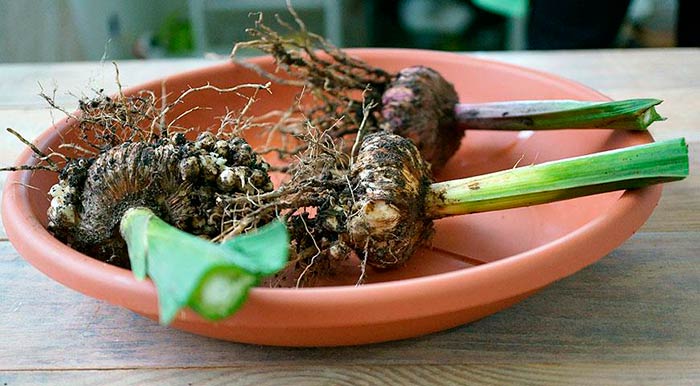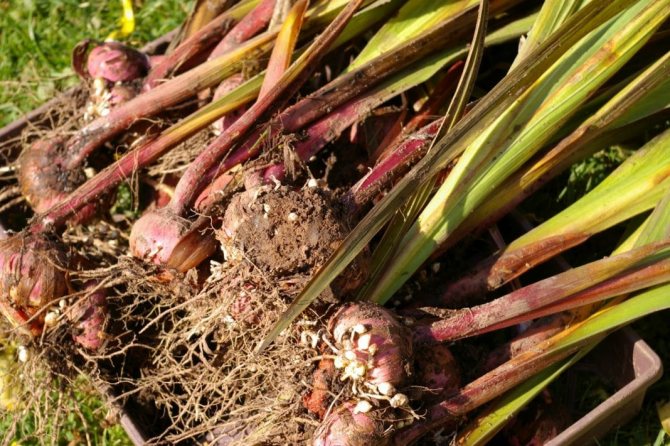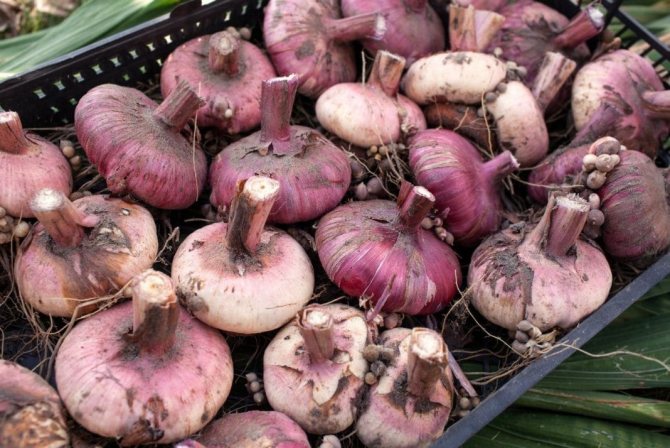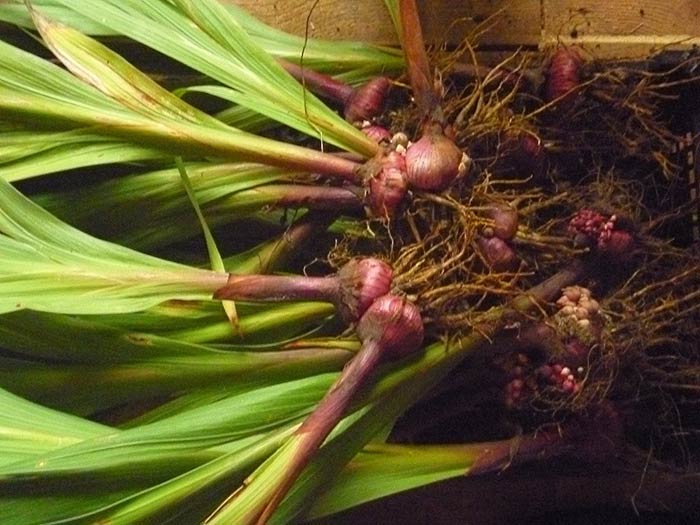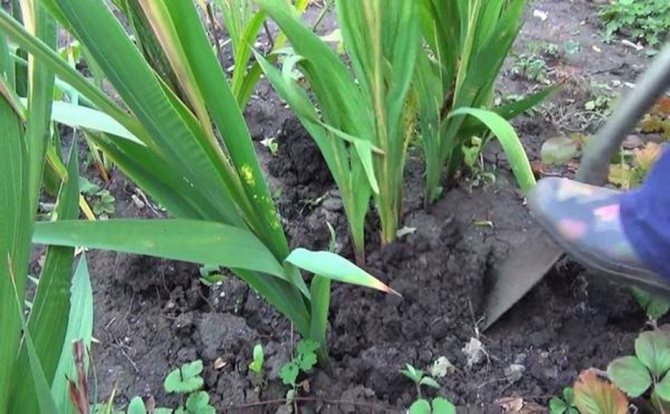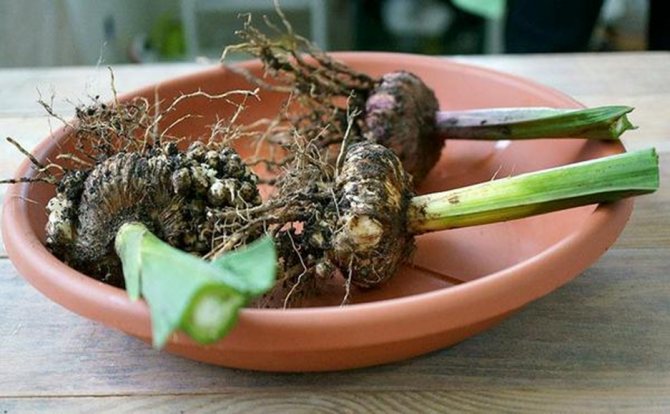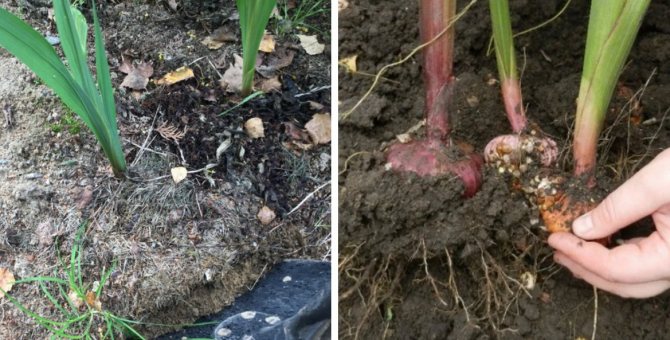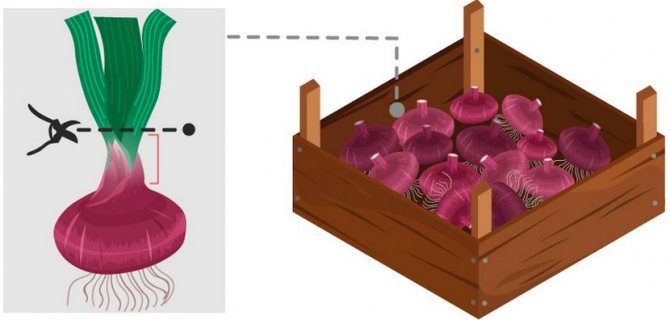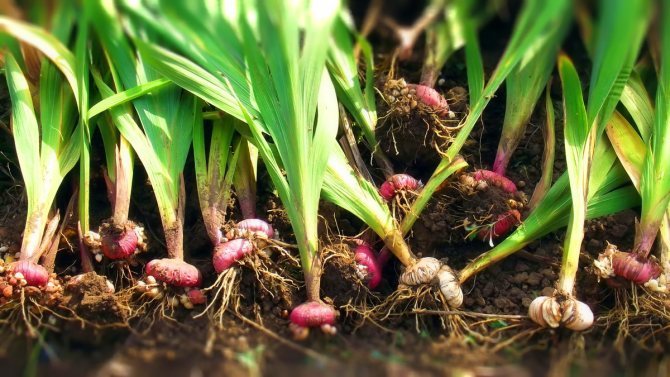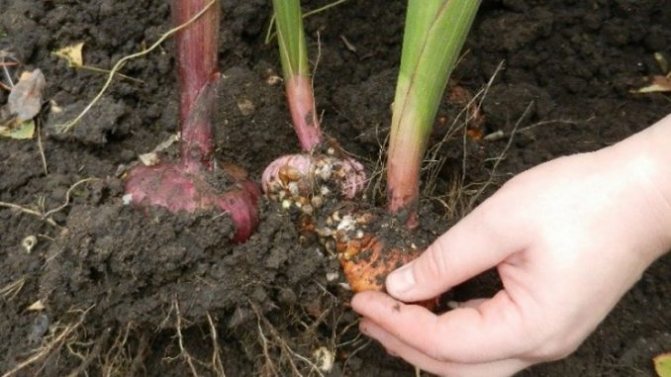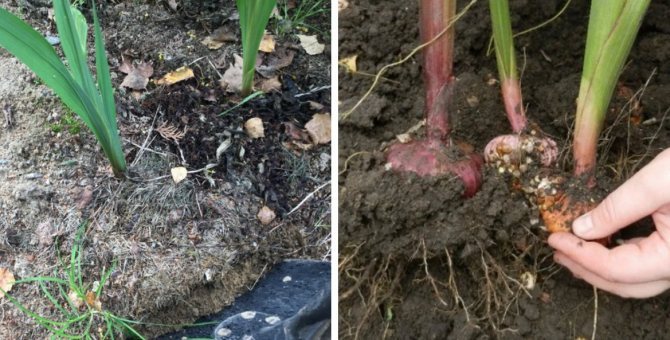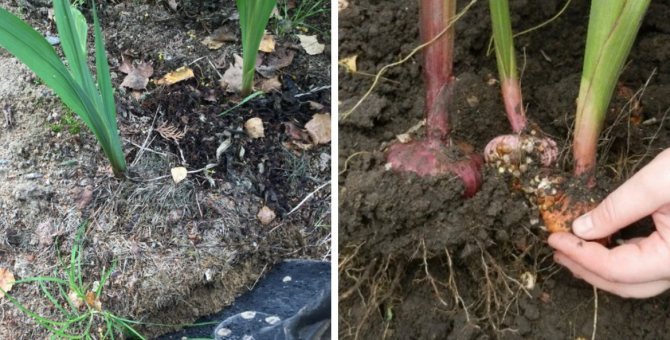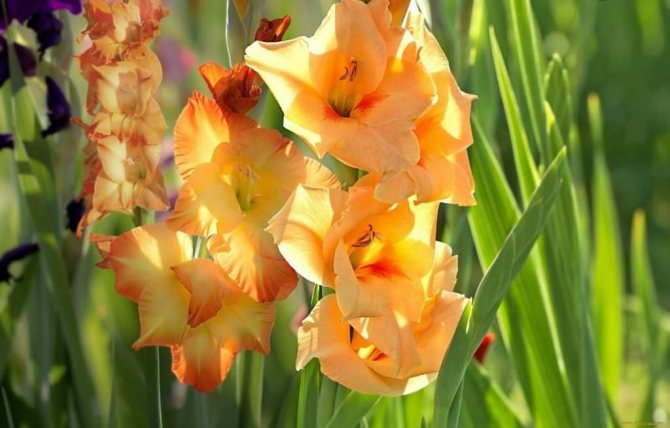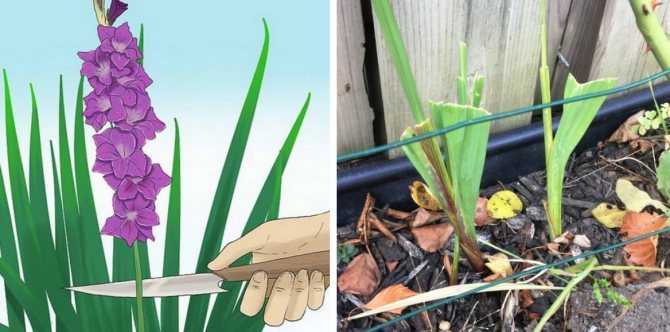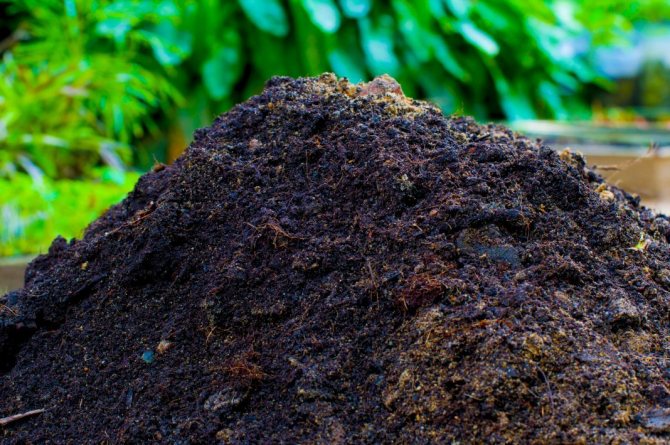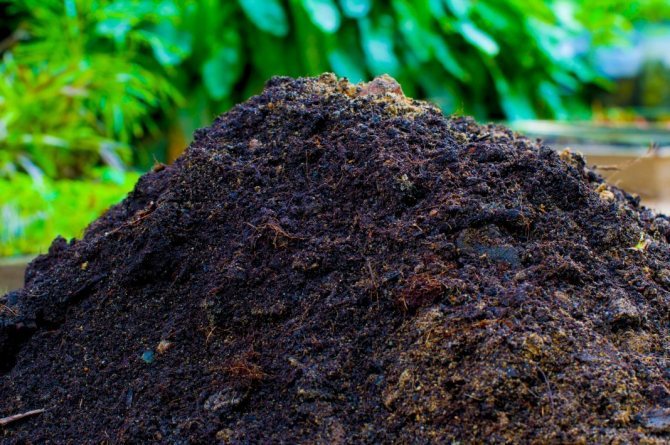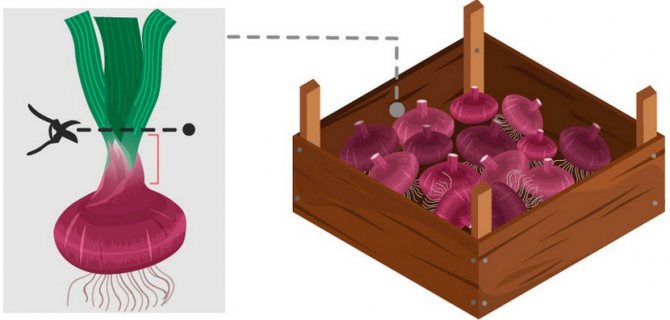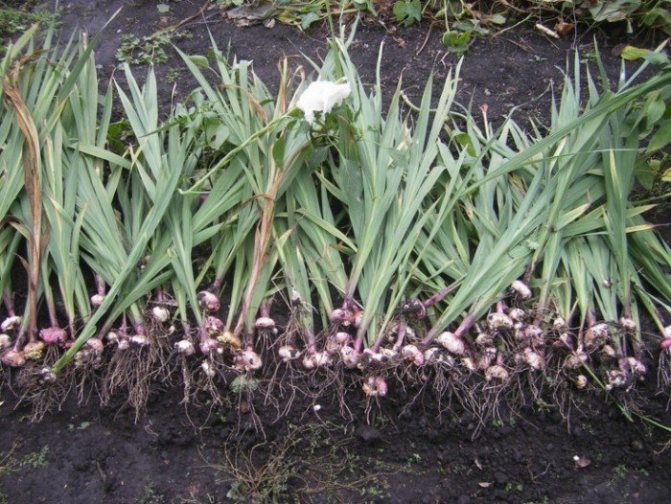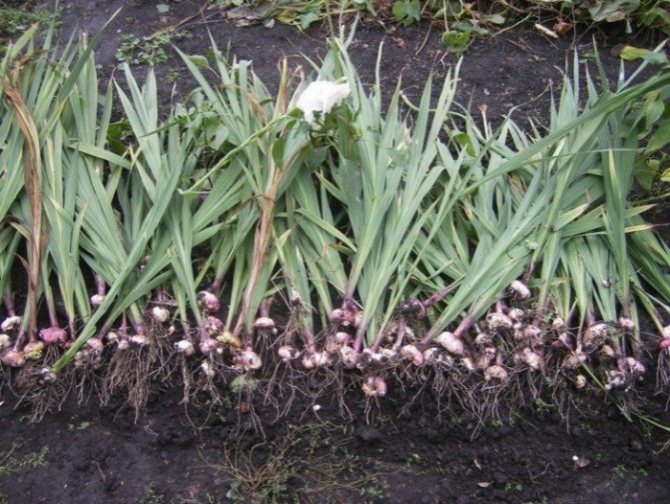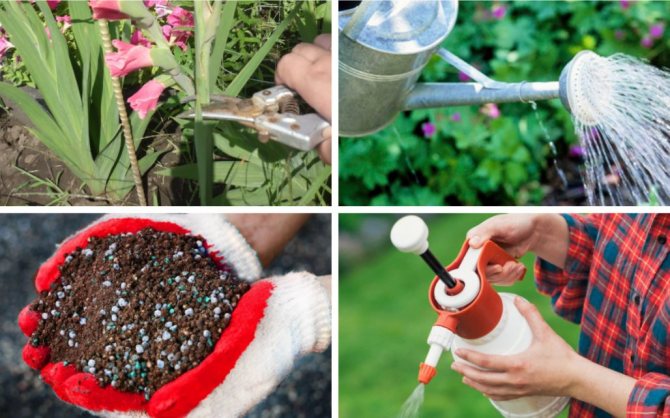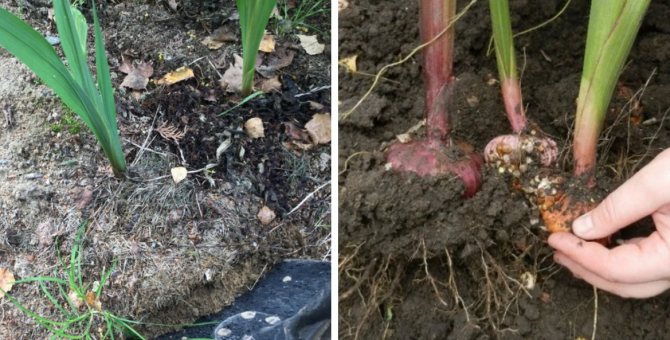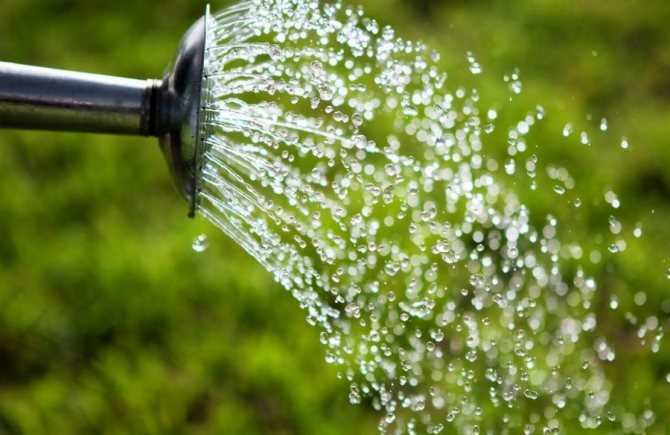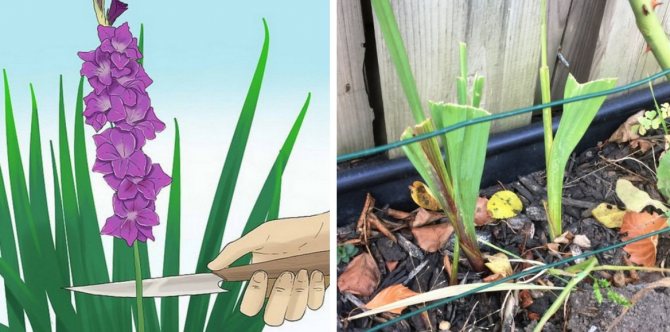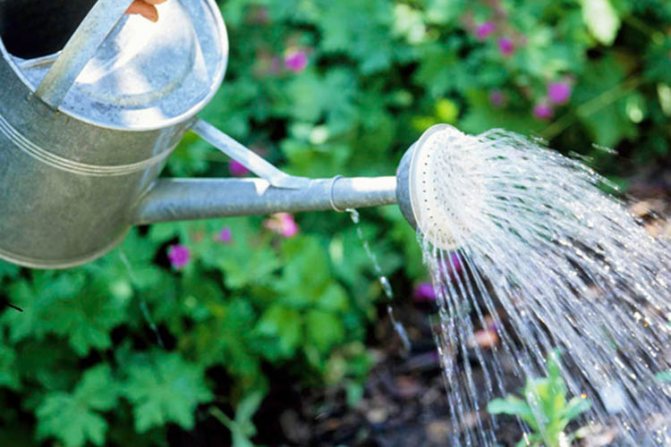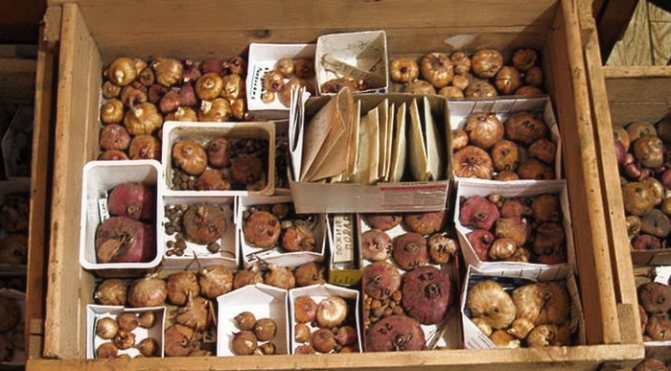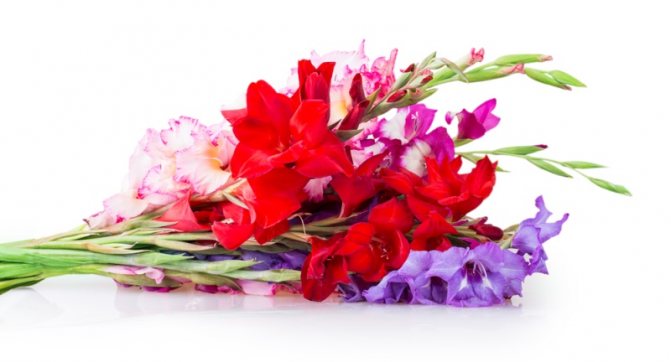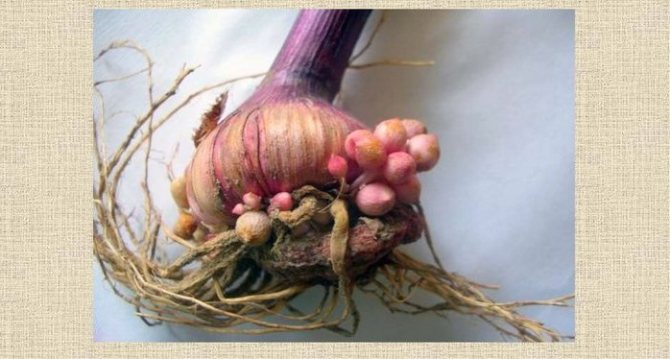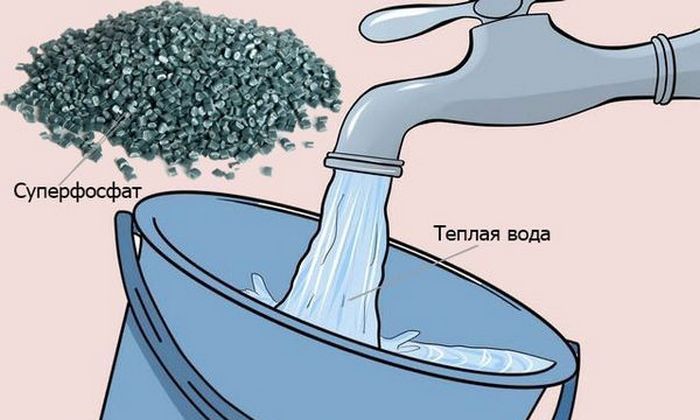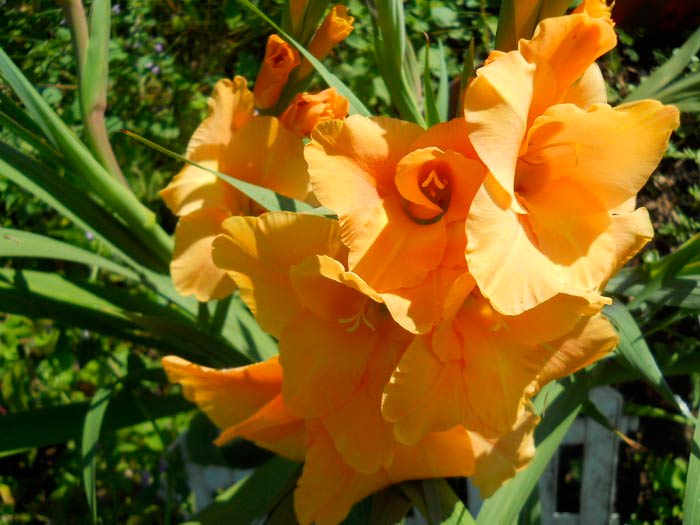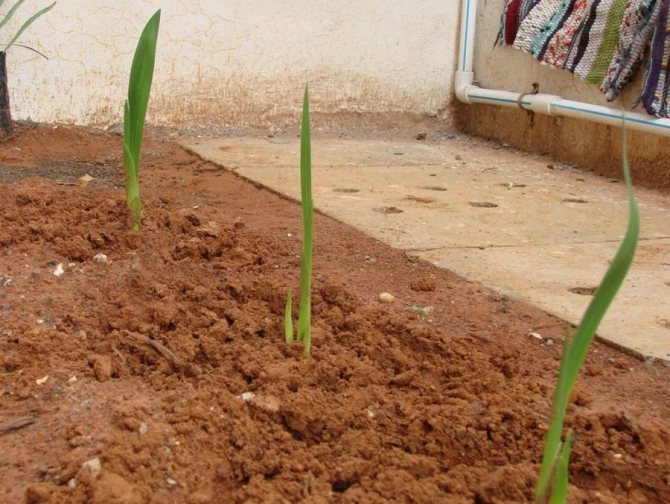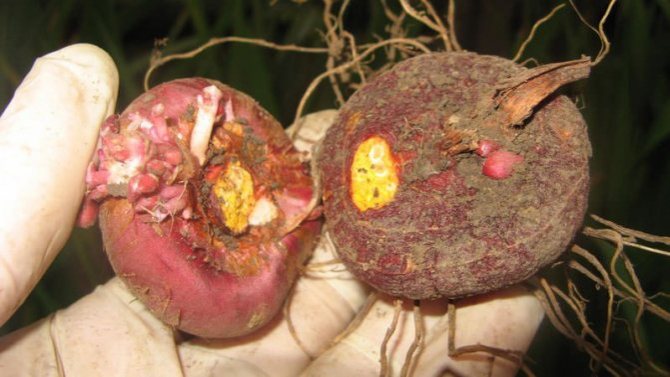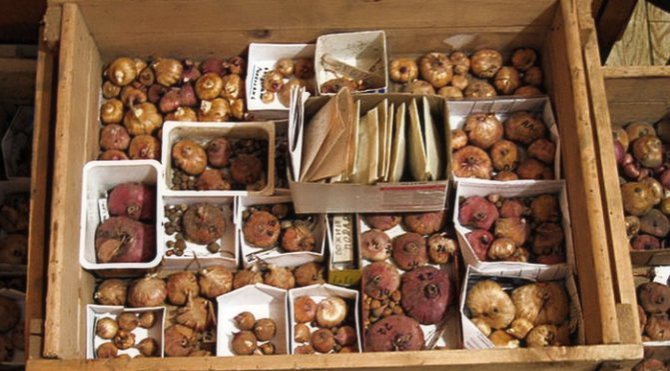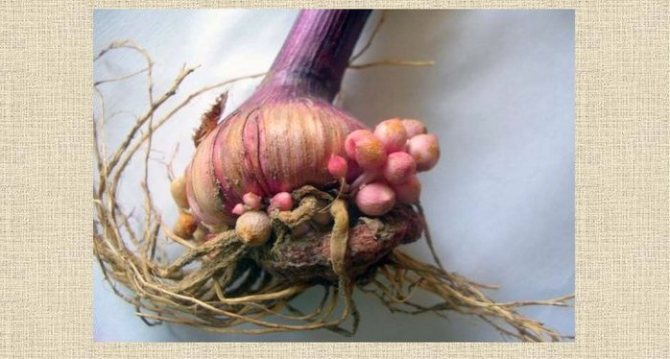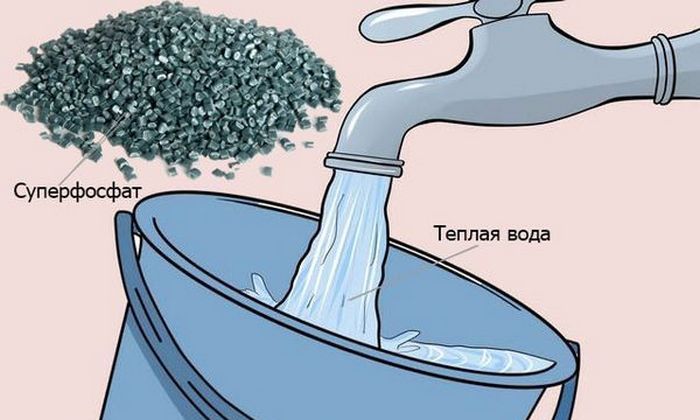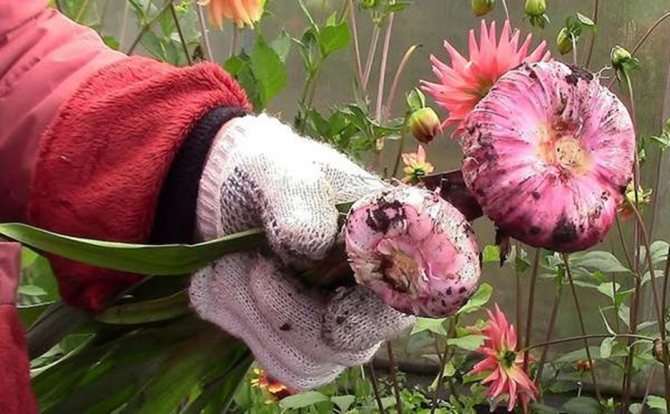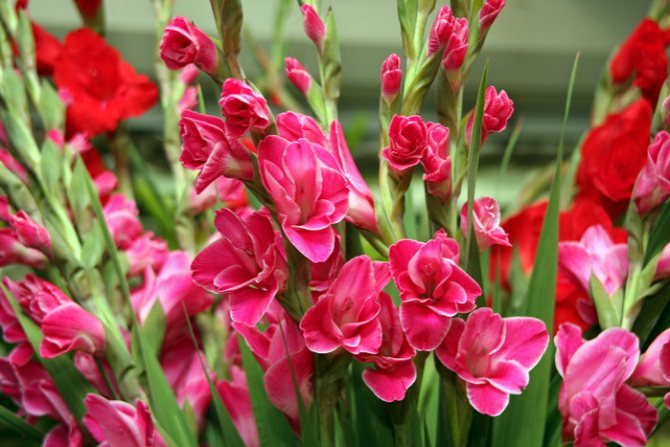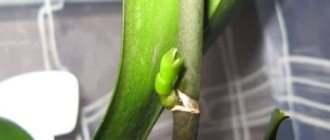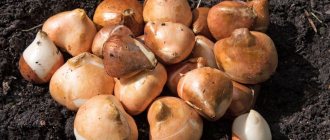Gladioli are beautiful flowers. They delight the eye in any flower bed with their slenderness and height. Flowers come in a variety of shades of purple, pink, lemon, powdery, and lilac. Florists do not always know what to do and how to care for gladioli after flowering. You can dig up the bulbs and store them, or leave them in the ground for the winter. When cultivating gladioli in central Russia, you need to know that the plant requires a transplant. When the flowers fall off, the root of the flower is dug out of the ground and stored for later planting in the spring. What work is still needed, and how to preserve the gladiolus bulbs?
Children of gladioli - description
What is a baby and what is it for
In the process of growing in adult gladioli bulbs, tubers are formed, which are called babies. They are analogous to the "parent" (corms), differing from it only in their size. From such children, with proper care, a gladiolus grows, which completely repeats all the characteristics of the parent.
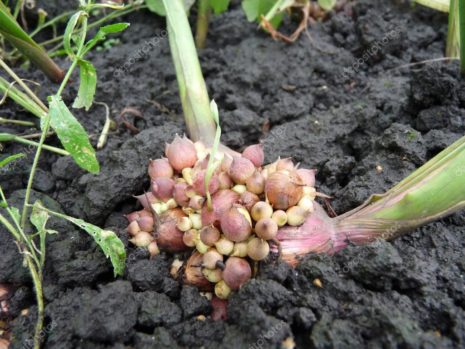
ON A NOTE! As practice shows, gladioli, which are grown from children, are more resistant to many diseases, and they also perfectly adapt to the conditions of a particular area.
The sizes of the children depend on the variety of gladioli, the age of the adult bulb, and agricultural technology. Crumbs grow completely - up to 1-3 mm, larger specimens are formed - 15-20 mm. Tubercles of the plant appear at the base of a large bulb, their number may be different. Some corms have 15-20 babies, there are varieties that give up to 150-200 tubers. Here, the peculiarities of agricultural technology, and the depth of planting of an adult bulb, varietal characteristics, and age of the plant play a role.
Adult gladioli bulbs have their own classification (analyzes from 1 to 4). In the same way, tubers are classified by size. The first group includes children, the size of which varies from 5 to 10 mm, from which plants with powerful peduncles, the most intense varietal color of inflorescences, and corrugation (if the parent plant had one) are obtained.
The second group includes a small baby, from which corms of 3 or even 4 parsing are most often obtained, with gladioli of a slightly lower quality.
IMPORTANT! There are varieties of gladioli, the genetic feature of which is a predisposition to a miniature baby.
Most of the modern varieties produce medium-sized tubers (up to 4-7 mm). Children have a dry and sufficiently dense shell, which serves as reliable protection against all external influences.
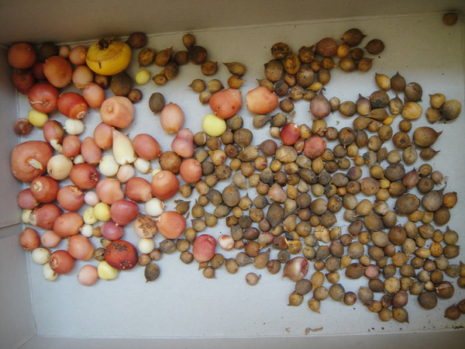

Inexperienced summer residents, mistakenly believing that children are unnecessary material, remove them from the bulbs during digging and throw them away. Meanwhile, tubers are one of the most important organs of vegetative propagation of these wonderful flowers. With their help you can:
- increase the number of gladioli in the collection;
- update the existing varieties, while preserving all the characteristics of mother gladioli;
- get plants that are maximally adapted to specific climatic conditions, to the area on which they grow.
Experienced flower growers know that a responsible approach to digging, parsing and storing tubers, as well as their further growing, will allow you to get bright and gorgeous flowers in the next seasons.
Storage rules and options
Seed material can be provided with decent conditions even in a city apartment. Flowers can be placed in the hallway or in the vestibule, in this case, each bulb should be wrapped in paper and placed in a plastic bag with a large number of holes.
If there is a glazed loggia, the tubers are laid out in boxes (certainly in one layer) and the latter are placed at a certain height from the floor. On days with severe frosts, the boxes are transferred to the room and placed closer to the balcony door. When deciding how to store gladioli after digging in very cramped conditions, you can dry them and provide them with wintering directly on the windowsill. It is necessary to inspect the material from time to time in order to quickly get rid of diseased specimens that can adversely affect healthy samples.
The tubers can be placed in the vegetable container of the refrigerator. They are wrapped in newspaper one at a time, forming several layers. In this case, you should always monitor the humidity level in the refrigerator, if the "twists" are covered with mold, the tubers are dried, the newspaper is changed to a fresh one, this procedure is repeated monthly.
The basement or cellar will be the best place to place seed material. In such rooms, a stable level of humidity is observed in conjunction with optimal coolness, which minimizes the loss of tubers. The bulbs are laid out in one layer in ventilated boxes, the latter can be stacked on top of each other. As a result, high-quality air exchange is formed without loss of usable area.
Experienced gardeners warn against placing boxes of vegetables and fruits next to the gladiolus bulbs, as they are capable of producing excess moisture. In such conditions, the risk of mold growth increases. If the tubers are nevertheless infected with it, it is necessary to quickly sort them out, fully dry, disinfect the boxes.
What to do after digging and how to store them?
Everyone knows that gladioli corms need to be dug up in the fall. The timing of the digging depends on the region, but it is important that the bulbs are ripe. Usually, flower growers determine the period by counting the days from the end of the flowering of gladioli or cutting the peduncles. On average - 30 days, in late varieties - up to 45-50 days. All tubers are separated from adult bulbs, washed gently and then laid to dry.
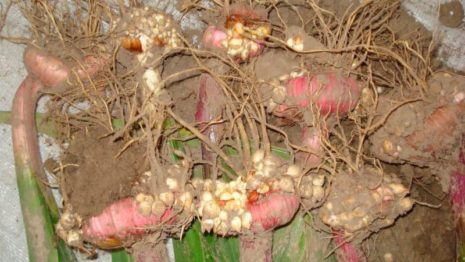

ON A NOTE! When selecting children, try to sort all the specimens and put them in storage. This will allow you to get a large amount of planting material for all varieties of gladioli in spring.
In winter, babies survive very well, much better than adult bulbs. For them, it is necessary to create an optimal regime:
- room with ventilation;
- temperature - from + 3ºC to + 8ºC.
The temperature at which children are stored should not exceed + 15 ° C. Every month it is necessary to look at the babies, removing damaged or dried tubers.
Care for gladioli in autumn in different regions
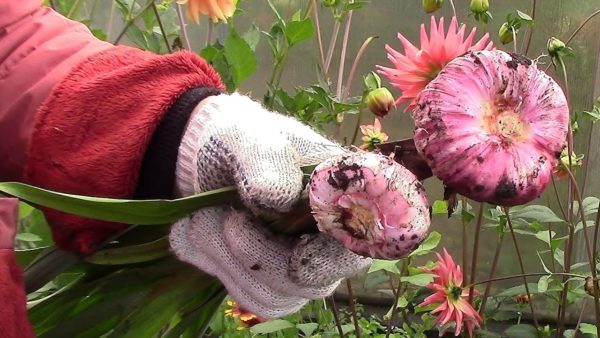

It is necessary to take care of gladioli in different regions, focusing on the peculiarities of the climate. They are dug out until the ground is completely frozen so that they do not freeze with it. Don't be in a hurry either. If the material is dug up early, it will not mature and will not germinate in the future.
In the north, the tubers are dug up in early October, in the south - closer to mid-October. In the Crimea and Krasnodar Territory, frost-resistant types of flowers are not dug up, but grown as perennials. They are sheltered from the cold with the help of spruce branches.
It is interesting!
Breeders have bred frost-resistant varieties of gladioli - tiled and Byzantine.
What to do in the fall?
Autumn activities with children of gladioli are reduced to their digging (together with adult corms), sorting, drying.The covering scales are not removed from the children; this will need to be done in the spring, before planting.
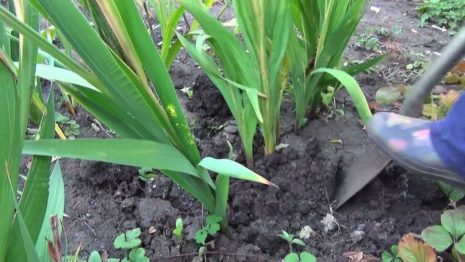

Note that if the corm has not yet matured a little, then the baby may have a light gray color and firmly attach to the "parent". This is convenient for digging, as the baby will not get lost in the ground. Fully ripe tubers have brown scales, and they often have already separated from the mother bulb. It is more difficult to choose them, as they are similar to soil and can get lost. Therefore, you need to very carefully look at the bed, not leaving individual children there.
Common mistakes when storing gladioli
- Do not remove the top husk from the bulbs. It protects the planting material from drying out. An exception is when processing with paraffin.
- You cannot store gladioli in plastic bags, even with holes. They do not allow air to pass through well, and condensation accumulates inside.
- Sprouted planting material must be moved to a cool room with diffused light.
Harvesting and storing gladioli is not as troublesome and difficult as it might seem to beginner gardeners. It is enough to remove the bulbs from the ground in a timely manner, dry and process them correctly, and in the spring they will delight you with friendly shoots and beautiful flowers.
Reproduction of gladioli by children
The method of breeding gladioli by children is one of the most common and simple ones. Thanks to this reproduction, all rare and beautiful varieties will be preserved in the florist's collection. Without working with tubers, these varieties will be lost as they age.
Frequent updating of children makes it possible to quickly get a large number of plants of your favorite variety of gladioli. Keeping the tubules correctly, caring for them, in just a few years you will get luxurious flower beds of magnificent handsome gladioli.


Keeping babies is not particularly difficult, and often it is these onions that are better preserved during the winter. Experience, of course, plays a role, since its own proven methods and techniques, certain rules for growing gladioli, which are best suited to specific conditions, appear.
IMPORTANT! Growing gladioli through a baby is not only a renewal of the variety, but also its improvement. Adult corms, which are grown from children, are complete planting material, free from viral diseases.
Is it possible to cut unblown gladioli
If you observe that the buds will soon be ready to bloom, you can safely cut the stems. The main thing is to keep as many leaves on the plant as possible. Do not cut flowers in the heat to avoid damaging the skewer. As a rule, if one bud has opened on each plant, therefore, it is time to collect the bouquets. And this contributes to the correct development of gladiolus, especially its corms.
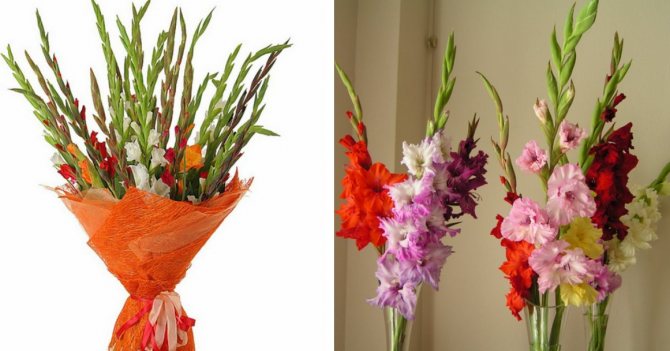

Do not rush to cut only those varieties for which the time of flowering will not come soon. There is no point in pruning too early - the buds have not yet had time to form and prepare for blooming.
Find out if you need to tie up gladioli.
Gardeners are so fond of gladioli that the skewer can be called one of the most common flowers in their backyards. Closer to autumn, people are bringing huge, colorful bouquets from their dachas. Large flowers are varied in color and shape, there are a great many varieties and hybrids. It is useful for every owner of a flower bed with gladioli to know how to care for plants, when it is customary to cut flowers, and how to save corms in winter for later planting.
How to keep children of gladioli in the winter?
After digging, the corms are cleaned from the ground, the children are separated, washed, and then dried for two to three weeks. Many growers process the planting material with special preparations before storing it, but this depends on personal preference.If there are a lot of gladioli, it is not always possible to find time for additional processing. But drying is a must.
Also, with a large number of varieties, it is advisable to mark the children, sorting them accordingly by name.
Bulb processing
Dug out and washed corms require further care before storage, which is disinfection and drying. The bulbs and babies should be pickled first.
To do this, they need to be sorted and processed in one of the following ways:
- place in 1–2% solution of potassium permanganate for 30–40 minutes;
- you can use the ampoule "Maxima", dissolved in 2 liters of water, the holding time is 30 minutes;
- or dissolve an ampoule of the drug "Decis" in 5 liters of water and treat with this agent for 40 minutes. bulbs;
- or use a solution of "Fundazol" for half an hour, and then treat the material with solutions of potassium permanganate or boric acid.
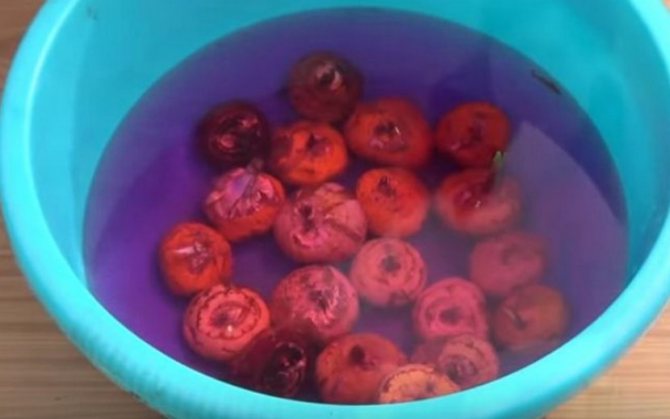

There are other options for disinfection: 20 g of chlorophos per 10 liters of water and 10 g of potassium permanganate for the same amount of liquid. Soak in each solution for 20 minutes, rinse, and then lower it first into water heated to + 50 ° C, then into cold water.
Did you know? Ancient warriors wore bulbs around their necks as amulets protecting them from death.
Drying is very important - it prevents rotting... At a temperature of about + 30 ° С, the bulbs are dried for a week, then at + 20 ° С they are dried for one month. Before the process, cover the corms with gauze, which is important to lay out for drying so that they do not touch each other.
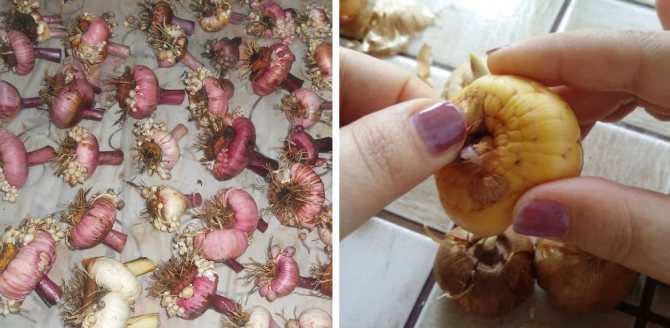

By the way, you need to peel off adult planting material, and children should not, because the husk serves as their protection. If the gardener does not have a place where the temperature can be controlled, he should dry the material for 2 months in a ventilated area or in the sun, but avoid direct rays.
Basic rules for preparing gladiolus children for planting
You may be interested in: When to dig out gladioli in the fall in 2020: the most favorable days for digging out the bulbs Dates for planting gladioli in the spring according to the 2020 calendar of gardeners and gardeners Growing gladioli in pots on the street
Each florist applies his own methods of preparation for planting children and gladioli corms. But there are general rules:
- it is recommended to cleanse babies from a durable waterproof shell, as it slows down the germination of flowers;
- you can also process the children in a solution of potassium permanganate (it is convenient to do this by spreading the tubers in gauze bags).
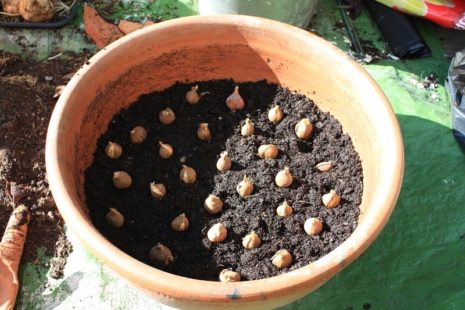

The soaking method can be used:
- the baby is placed in warm water for 24 hours so that it swells;
- then put it in jars, containers, other containers, covering it with a damp cloth;
- containers are placed in a warm place;
- control moisture, not allowing the napkin to dry out.
After about 7-10 days (it all depends on the condition of the tuber and the conditions), you can see the sprouts. Baby is ready to board!
Features of care after flowering
When the flowers fall off, peduncles remain in their place, which spoil the appearance of the garden plot. After flowering, you need to cut the stems of flowers at a height of no more than 30 cm from the ground. It depends on the type of gladioli. This procedure gives a neat and tidy garden, helps to prepare the bulbs for winter.
Attention! For the ripening of the bulb, the presence of nutrients is important. Trimming the stem promotes the accumulation of minerals in the tubers. It will increase the yield, give decorative properties and increased germination.
After the end of flowering, gladioli care is performed in the following order:
- 1 Pruning the trunk and leaves.
- 2 Top dressing with fertilizers.
- 3 Treatment with chemicals to protect against disease.
Such procedures enable healthy bulbs to ripen properly. Pruning flower stalks and foliage creates conditions for the formation of bulbs. Plants do not expend energy on seeds.It is necessary to control that the height is more than 20 cm to obtain the required amount of nutrients.
Fertilizing increases root growth. Therefore, it is necessary to fertilize bulbs that are backward in development. Dry dressing does not work, fertilizers are diluted with water. Superphosphates are poorly soluble in water. Superphosphate extracts are used to feed gladioli. 200 g of this chemical is poured with boiling water in a volume of 1 liter, infused for 1 hour and 30 minutes. The solution is cooled and dissolved in water: 1 glass in a bucket of water. This volume is enough to feed flowers for 1 sq. meter.
Watering after circumcision is not required to prevent fungal infections from developing. Dry soil contributes to the concentration of nutrients in the bulbs. The last fertilization should be done before the beginning of September. To do this, use potassium permanganate 5 g and dissolve it in a bucket of water. This disinfects the plant, protecting it from disease.
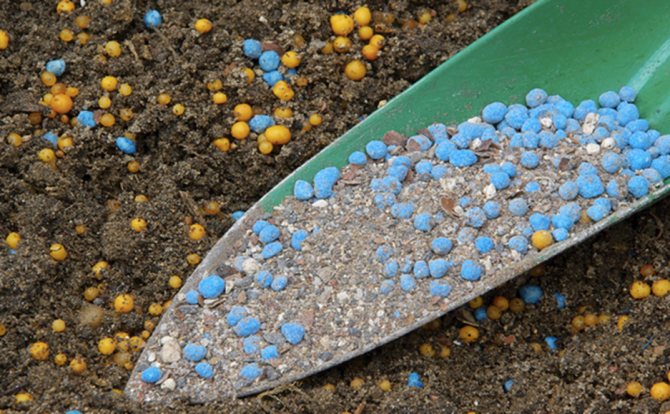

Thrips are flying pests that eat gladioli bulbs, leaves and stems. Pruning should be done faster to keep out insects. The garden bed, where there are still tubers left for ripening, needs to be weeded out and check if there are thrips there. The bulbs are treated with karbofos by immersing them in a solution for half an hour. At the beginning of September, the feeding is finished and the tubers are given the opportunity to prepare for winter and fully ripen.
Growing seedlings
If you have time and desire, you can always grow seedlings from children. What does it do?
- Fast production of a full-fledged bulb in the same season.
- The ability to use all the planting material without the loss of children (even the smallest ones).
Closer to spring, small children may dry out. To avoid this, you can transfer them to storage in the refrigerator, or you can plant them in prepared containers with soil and grow seedlings.
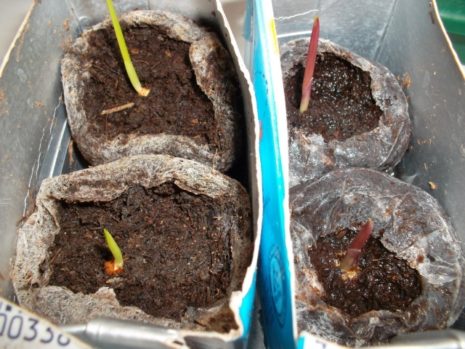

It is recommended to plant the baby in separate cups, pots, cassettes, since the roots of gladioli are fragile, they can be damaged during transplantation. Planting separately helps prevent plant death.
The timing of disembarkation depends on the region, since it is necessary to take into account the time of the possible landing of gladioli on the ridges. Usually, the seedlings should be 30-45 days old, so when disembarking at the end of May, the children are planted for seedlings in mid or late April.
IMPORTANT! Gladiolus seedlings must be provided with an optimal temperature regime (so that the seedlings are not hot), as well as good lighting. The best temperature is + 15 ° C, since in such conditions a powerful root system is formed, and the seedlings do not stretch out.
Watering seedlings is best done through a pallet, so the risk of flooding the plants is eliminated. A week before disembarkation, it is recommended to harden the gladioli, taking the seedlings of the children into the open air. The time spent at first is no more than 30 minutes, then the duration of such "walks" is increased.
What to do with children in spring
With the arrival of warmth and sunny days, tubers are prepared for planting. The baby is covered with a tough protective frill that can slow down pecking and sprouting. Germination can be accelerated in two ways - cleaning and soaking.
Selection of babies for planting
In the spring, the material is taken out of the storage area, all rotten, dried specimens are discarded. For reproduction, it is better to choose the largest bulbs, because their varietal characteristics are more pronounced.
But it is important to take into account that a small baby, but with three root tubercles, will give a stronger and healthier plant than a very large one with a single tubercle.
Cleaning babies
The easiest way to free the bulbs from tough scales is by manual cleaning. This is usually done 1-2 weeks before planting in the ground, but you can clean it earlier - a month. So that the cleaned material does not dry out, it is placed in a polyethylene bag and stored in the refrigerator.
The cleaning process is not difficult: find the top of the tuber, pick up the shell and pull it down.
Note: it is good if the children lie in a dry place before cleaning, since dried covers are easier to remove.
Soaking babies
Exposure to moisture before planting helps to soften the tough protective shell. Soaking can be done in different ways.
Method number 1:
- place the baby in heated (38-38ºC) water for a day;
- wait until it swells;
- take it out of the water, wrap it in a damp cloth;
- place in plastic bags or containers;
- put on a light and warm windowsill;
- do not allow the fabric to dry completely.
A signal of readiness for planting will be the appearance of miniature sprouts and roots.
Method number 2
Soaking is done just before planting. Prepare a warm soda solution (a tablespoon per liter jar) and lower the gladiolus babies there for 12 hours.
Method number 3
A baby gladiolus is placed in hot water (about 50ºC), left for 1.5 days. Then the liquid is drained and a new one is poured up to 40ºC, kept for another 12 hours and planted.
Note! For the prevention of diseases and damage by pests, regardless of the preparation method, treat the tubers with solutions of broad-spectrum insecticides (Aktara, Prestige).


Planting and leaving
Children are planted (or tubers themselves, or already seedlings) only when the soil warms up to + 10 ° C. For babies, they make a separate bed, digging and loosening it in advance.
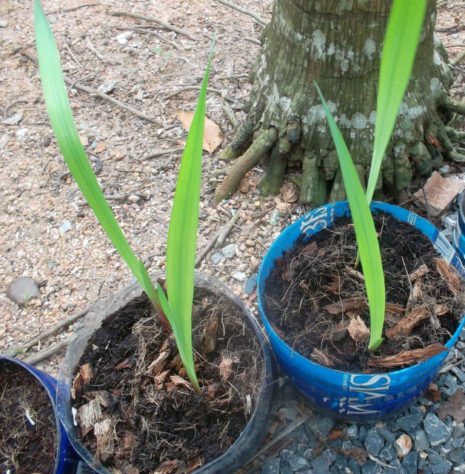

Planting depth is on average 3-5 cm, the distance between plants is up to 5 cm.
ON A NOTE! The cleaned baby is planted to a depth of 4 cm, the germinated one - deeper, by 5-6 cm.
They are planted in grooves, they are first spilled with water. Rare planting of children allows you to get rather large bulbs already in the first growing season. But this is not always possible (the areas of the plots are different for everyone), therefore many growers plant the tubers of gladioli at a distance of up to 2 cm.Autumn, the bulbs will, of course, be smaller than with a rare planting, but after a year they will be completely conditioned.
Further care is simple:
- watering;
- loosening;
- top dressing.
On loose soils, watering is carried out more often than on clayey, but it is also impossible to overfill. An excess of moisture leads to decay and death of plants.
They begin to feed gladioli approximately 30-35 days after landing in the ground.
IMPORTANT! First, they water the plants, and only then they feed them.
In total, up to 5 dressings are carried out, the interval is 10-12 days. In the first weeks, nitrogen is given (diluted mullein, poultry droppings), later it is convenient to use complex fertilizers. A good effect is given by watering gladioli with herbal infusions ("green" fertilizer).
When the peduncle is ejected on children, it is advisable to break them off so that the plant spends all the nutrients on the formation of a high-quality and full-fledged bulb. Often, flower growers do this: they leave two lower inflorescences on the peduncle to make sure of the gladiolus variety.
During the cultivation process, it is necessary to spray the plants to prevent diseases. To do this, use:
- potassium permanganate solution;
- boric acid solution;
- zinc chloride;
- HOM preparation (according to the instructions).
Effectively dust the soil around the plants with ordinary wood ash. Firstly, gladioli love ash, as it improves the structure of the soil, making it loose and breathable. Bulbs feel very comfortable in such conditions. Secondly, ash is an excellent fertilizer. Further, it prevents the infection of gladioli with various infections, and also repels various insects. Among them are thrips, as well as wireworms and slugs.


In mid-August, any feeding is stopped, and the watering of gladioli is also stopped. This allows the bulbs to accumulate the necessary nutrients, to increase "weight" and size. In addition, the bulbs of fattening gladioli are worse stored in winter, they are more likely to get sick.
How and when to cut gladioli correctly
First you need to familiarize yourself with the rules and the time period for cutting the skewer for bouquets:
- If the flowers have begun to bloom a little, you can already place the peduncle in a vase.
- Cut for bouquets in the morning.
- Carry out the event only with a well-sharpened knife so as not to damage the plant.
- Immediately immerse the stems in a container of water.
- Remember that the flowers are massive - set them in wide-bottomed vases.
- Store cut flowers in water in a cool place.
- Change the water after 2-3 days.
- Remove faded flowers gradually.
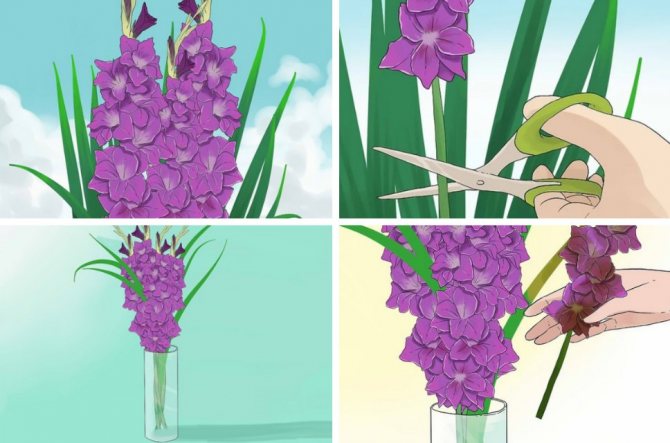

The time will come when the skewer will fade - first early, then late. While flowering lasts, watering should be carried out. It can be everyday (in dry weather), and rare - from once a week or even two weeks. The bulb is located at a depth of 30–35 cm, and the soil must be moistened at such a distance.
Important! If you add half an aspirin to the water, the flowers will receive additional nutrients and the bouquet will retain its attractive appearance longer.
The ground under the planting of the skewer must be loosened, it is useful to slightly huddle the plants. Weeds need to be removedb, and so that the soil moisture is constant and moderate, the weed does not grow abundantly, mulching is carried out.
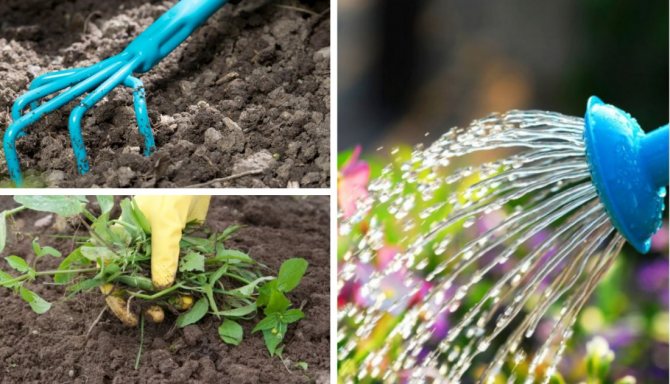

When gladioli fade, they urgently need to be cut. The removal of peduncles is described above. Do not forget about the rules for cutting. Pay attention not only to the condition of the flowers on the plant to determine when to remove the stems, but also to the temperature of the air. An obligatory rule is to remove the peduncles before the onset of stable cold weather. It is important to let the corm mature.
Did you know? In ancient Greece, gladiolus was considered a weed that grows in wheat fields. It was pulled out and burned along with the onions.

